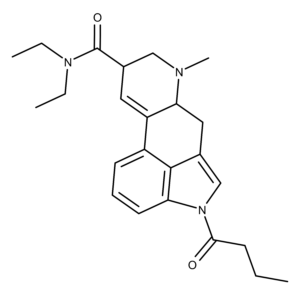The Chemistry of 1B-LSD
The scientific literature contains virtually no information about 1B-LSD. It belongs to the ergoline family of compounds, which includes LSD. The chemical structure of 1B-LSD differs from LSD by having a butanoyl group on the nitrogen atom in the indole ring.
The Pharmacology of 1B-LSD
A recent study found Ki values for 1B-LSD of 345 nM, 87.7 nM, and 20.8 nM, at serotonin 5-HT1A, 5-HT2A, and 5-HT2C, respectively.1 Receptor activity studies indicated that 1B-LSD is a very weak partial agonist at the human 5-HT2A receptor compared to LSD, but it did induce the head-twitch response in mice. However, 1B-LSD showed no agonist activity at 5-HT2A and 5-HT2C despite showing comparatively high affinity those receptors compared to LSD. Additional work indicated that 1B-LSD produced a dose-dependent increase in head twitches.2 Also, the data showed 1B-LSD had about 14% of the potency of LSD.
The data from a November 2019 study indicates that 1B-LSD is a prodrug of LSD.1
The Applications and Potential of 1B-LSD
As a prodrug of LSD, 1B-LSD may provide drug formulation options due to its different solubility and other physical properties.
